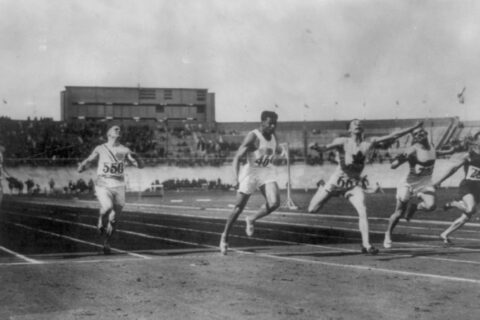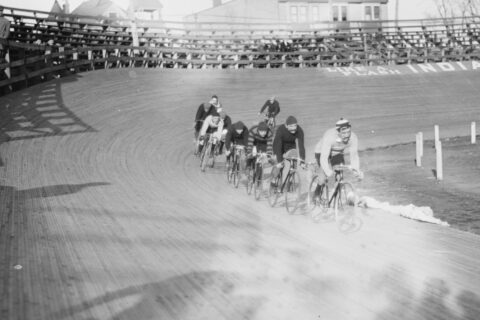Bobby McGee helps pro runners and triathletes find speed with improved running form, but these performance gains are for all ages.
Video Transcript
Bobby McGee 0:06
Hi, my name is Bobby McGee, I’m an endurance coach, have been doing so for over four decades, and I specialize in running mechanics and mental skills.
Bobby McGee (speaking to athlete) 0:19
Everything’s there—that’s volleyball, that’s basketball—it’s all here. It’s never here. Okay? So that’s who you are when you run. All right, you’re in that position there. And it’s so easy to find it by just going [exhales sharply]. There it is, forget it, stay in that position. Mid race, if you’re looking at the clouds, you’re going, “Uh oh, I’ve lost—I’ve popped my top. [exhales sharply] Okay, now I’m looking 40 feet in front of me, that’s where I want to stay.”
Coaching Masters Athletes
Bobby McGee 0:44
When I talk about the masters athlete, I’m talking about athletes that come to me, and they’re already very successful individuals; they see benefit in that approach. But this is a cry to the weekend warriors. All those people that are thinking about getting into endurance sports, but thinking it’s now beyond them, their time has passed. And there’s such magic in it. The only challenge is, you have to stick at it for a little while. This persistence—that’s the only downside of endurance sports—is right at the beginning: that it takes a while for the drug to kick in. You have to stick at it for a short while before you have that great run. And it doesn’t hurt to be doing it properly by the time that arrives. And the nature of the beast is that the older athlete goes longer and longer, all right, and then they lose that ability to develop power. And it’s a physiological reality as well, right? They get weaker from a strength perspective, and so they just go further but a little slower, because they can manage that. But what tends to happen is they keep adjusting their form based on them losing power, losing ability. And so in so doing, they actually cause those fast-twitch fibers that stabilize their knees, and that stabilize their ankles and their low backs and their hips to atrophy even further, and they become more sloppy runners. And they tend to be, not only then slow down, but they get injured as well.
2:22 – That whole historical approach of, “Okay, you’re weak there, let’s get you stronger,” doesn’t fix what causes the injuries, right? What causes the injuries is a movement dysfunction. And a lot of that comes as a result of atrophy, of support muscles, which tend to be fast-twitch fibers, as opposed to the slow-twitch stuff that comes from all the training. So some of the challenges that coaches of the masters athlete incur, and the masters athlete themselves incur, is the fact that they are unwilling, because they feel they are unable to address the running mechanics of the masters athlete. I think that would be the primary fault, if it were, that the coaches and athletes make. It’s just like, “It’s always been like this, I’ve been doing this for a long time, and I just don’t know if it’s worth the risk of changing it.” And you see that in many sports, right? That’s often the case is I’d rather be inching slightly forward, or staying on this plateau of where I am, than taking a risk of taking a couple of steps backwards, so I can make some real advances going forward. And I think with the masters athlete, that’s common, right? So if the masters athlete’s being coached by even a slightly younger coach, the coach might say, “Look, it’s not something that I think we should mess with. The risks might be too high.” But what’s actually too high is the losses in possible performance.
3:49 – So I think that if you had to say, what advice would I give to a coach or a masters athlete in that regard, is to be more courageous. To be more brave, to take some risks, which are actually no more—if you’re doing it the correct way—no more than the status quo, right? You’re looking for more performance. These athletes are fit, they know how to train, they’re disciplined, but they’re not getting the performance improvements they could get if they were addressing some mechanical fundamentals. When I start working with a masters athlete, it’s seldom, if ever, do I look at the athlete and say, “From a mechanical standpoint, I’ve got nothing to offer this athlete. There’s no way that they can improve.” There’s always something that they can improve.
4:38 – Also, there’s no formula for runners, masters runners in general, in terms of their mechanics. I would never say that. Masters runners all tend to do this, right? So each one is an individual, each one is an experiment of one, you know? How they are built comes into play. And not necessarily a gender thing, but there are gender differences in terms of their structures, which you can address. But in general terms, I’m looking at the ratio of their torso length to their leg length. We know that swimmers tend to have longer torsos, broader wingspans, and shorter legs. Whereas with runners, both from a physiological standpoint, and in our case, from a mechanical standpoint, runners have very short torsos, shorter arms and have much longer legs. But you know, when you’re working with the amateur masters athlete, they come in all shapes and sizes, and you have to bear those in mind.
The Three C’s
Bobby McGee 5:37
So I have some simple things—you know, running defined is still always, no matter what age you are, running is stride length times stride rate, that equals running speed, right? And so what you looking at is those two things. How can you optimize their stride rate or their cadence? And how can you optimize their stride length? And so you’d look at the runner and say, Why is their cadence slow? Or why is their stride length too long or too short? Or why are they over-striding and start from there like you would with any athlete. So when it comes to applying some sort of sequencing of work with an athlete, I would look at what I call the three C’s. So the first thing I would look at is whether they are connected. In other words, are their arms, their shoulders—and more specifically, their torso—working in unison with their hips and their legs? So that’s the connection component. So the big one that I spent a lot of time with on the connection is when they do what I call popping the top, as that’s when their chest comes up, and they arch the low back, and they anteriorly rotate the pelvis.
Bobby McGee (speaking to athlete) 6:55
So what you want to do is that the exhalation will sit your head, right. So if you look up at the clouds now, and you do that quick exhalation [exhales], see where your eyes go: 40 feet in front of you. That’s ideal, okay? Nothing moves except your thoracic spine. Just that, that’s all that comes down. Okay? So push down.
Bobby McGee 7:14
So that’s a disconnect of the ribcage from the pelvis. So that’s why that connectedness goes missing. So that gives me a cue straightaway where I can go and work on. The second one is for them to look at how compact they are. So running is essentially, in distance running, it’s all about economy.
Bobby McGee (speaking to athlete) 7:35
Then we get to the arms, right? So we know with your arms, you tend to have your elbows wide. So we want, when your elbows are wide, you got a lot of work to do, so you lift up your shoulders. So now you’ve learned the scrunch-release drill, the further that we can get your shoulders away from your ears, the better. All right, and that’s that scrunch-release. Right, so now the chest is down, you’ve freed up the upper arms. Now the arms; you’ve got a glass tutu on there, all right? And you cannot break that glass tutu, you have to stay above it. So that’s where I want to keep that arm angle. Good.
Bobby McGee 8:07
All right, so instead of all of their elastic return and all of their energy driving them forward, they are wasting energy to stay in balance; they’re going side to side, or their arms are flailing, or their feet are externally rotated or internally rotated. All of those things fall in that compact area. And then the last one is—and it’s almost like the last one is an “equals”—if they get the connection right and they get the compact right, then they can get their cadence optimized. And as a general rule of thumb, I would say with a masters athlete, whatever causes them to lose cadence is probably the biggest error they can make.
Bobby McGee (speaking to athlete) 8:46
So, last thing, put your feet down. Don’t drop into the ground, come to the ground. Like you’re running on river rocks or like you’re running ladders, you have to look where you put your foot down. Put, put, put the foot down as opposed to [makes noise] just letting it drop down. That makes everything softer and everything quicker; brings your cadence up.
Bobby McGee 9:10
Alright, so whether they are over-striding or whether their posture’s too upright or whether they are utilizing that kinetic chain by dropping their arms down and slowing their cadence down, they are increasing load, they are decreasing economy, they are upping the risk of them getting injured all along, all the way down the chain, from the hips to the toes. And so the easiest part of my job is to look at, is this runner’s form doable when they’re fresh and is there a lot of deterioration across longer running, right? And so most of these injuries come to these athletes from overuse, right? So it’s when they’re doing slower stuff for longer, all right? They don’t necessarily often get injured in a race but when they train, that’s when they get injured, right? So I’m looking at what is deteriorating over the course of the run.
10:05 – I’ve had some, I had an athlete who was a world champion, who would have me show up deep into her long run so that I could observe her then when she was fatigued, and then we could work on those things. And a lot of that is conditioning, right? So this athlete can hold on to the form when you are running an race. So when you’re doing a training session, the last thing you want to do is cognitively intervene with your running form when you are fresh. Because it’s using two completely different parts of the brain; the one is a reflex action—cognitive intervention is disastrously uneconomical, right? They will use more oxygen, their heart rate will go up, they will feel uncomfortable, and they might even get hurt. So what you want to do is to teach them cues that later on in a training session, later on in a run, they can assess where they are with those various components.
The Goldilocks Drill
Bobby McGee 11:01
Whenever we work on these bits and pieces, you can sometimes lose an athlete, you know, especially a masters athlete, or a very young athlete, all right? Because you are so excited about what’s going on and you understand the whole background, and they’re only getting the two-dimensional picture of, “What must I do,” you know? And so, the drills are always designed to bring forward those three C’s, right? That’s what we’re trying to do. And also address whatever specific issues, you know, that that athlete brought forward. But at some point in time, these things need to be culminated in running. And running is a very automatic thing. And in fact, it’s more than automatic, it’s primal. So at some point, you have to get the athlete to do something, to do a drill, that brings everything together and that they get the result they want without thinking about it.
11:52 – So I do something called a Goldilocks drill, which is basically set the athlete up for complete failure, all right? And have them do everything we’ve been working on exactly the opposite of that. And it’s a really fun drill. People get into it instantaneously, right? So you’re basically having them run in a very foolish manner: their heads are up, their chests are up, their arms are down. They’re running forward in little series of leaps. And then you give them the cues while they’re doing that, so that they understand how the cue works.
Bobby McGee (speaking to athlete) 12:20
And I’m just going to give you one cue after another, all right? Just as you would do with yourself when you’re training, especially when you’re doing quality training, especially when you’re in a race and you’re lucky. All right, so I’m on that side of you. Okay, here we go. All right. First thing is drop the chest. Good. Bend the elbows, bend the elbows. Hit the elbows back, hit the elbows back. Good. And hurry the feet to the ground. Get ’em down, get ’em down, get ’em down, get ’em down, get ’em down. Great.
Bobby McGee 12:51
And then you immediately stop them and you say, did I tell you to run faster? Did I tell you to run with a higher cadence? Did I tell you to lean forward? Did I tell you to do any of those things? Did that feel softer? Easier? Quieter? More effective? Yes, yes, yes, and yes. But at no point in time did I ask you for more effort. So you reached into a toolbox, you pulled out effortless things to do just because you were aware. So the big mistake, I think in the, with the coaches and with athletes themselves—thinking I’m trying to change your movement, I’m trying to sell you an infomercial way of doing this form. But I’m not. I’m trying to get you to move the way you would move when you were 14, 15, and 16—had you not lived in a polluted environment, had you not worn shoes, had you lived on dirt roads, and had you run to school every day. That’s how I want you to get to move. And you’ve just shown that you can move that way, all you needed was these cues. But that presupposes that we’ve done all those fundamental steps beforehand, getting them to there so that they understand what each one of those cues meant. And again, not when they’re fresh, only later on.
Mobility, Balance, and Stability
Bobby McGee 14:09
So especially with the masters athlete that has lost elasticity, has lost the rebound effect, it’s important to realize that the vast majority of endurance training is for slow-twitch muscle fibers. It’s all about oxygen transportation and turning that oxygen into running energy, all right? But what people don’t realize is that a sport like walking is a strength activity. Whereas running is a power activity. Running is rebound; it’s stabilizing the platform and rebound. So if that platform is not stable, then whatever rebound the athlete has available is not being delivered, right? So the athlete has a basketball, has a pump, but has got a deflated basketball they’re trying to bounce. And so my job is inflating the basketball and bouncing it in the correct fashion.
15:00 – All these years that I’ve been working on, you know, I’ve started working on this before I was a masters athlete, now I’m a masters athlete, right? So during the drills, I was one of the first proponents in distance running in probably the early 80s, where we were talking about, “Should runners do weights? Should runners be strong?” Right now we know they should be; triathletes should be strong, runners should be very strong, right? But to realize that those fast-twitch fibers need specific kind of work. So not only do you need the skills component, which would be the running drills, all right? That would be one pillar of addressing a runner’s form, all right? But the other component is dynamic mobility. There’s specific reflex actions in running that require a specific range of motion. For example, if you cannot get your knee behind your other knee when you’re running, you can’t elicit the hip flexor reflex, you can’t get that knee through for free. You have to actually lift it through. That’s what happens to triathletes all the time, we call it running with your bum in a bucket, all right? So you need that dynamic mobility work, which serves—especially with the masters athlete—serves as a diagnostic tool, as well as a restorative tool. So you can see where they require the range of motion, all right?
16:18 – And then with that comes this need for balance and stability. So if you think of your hips as a table top, and your legs as the legs underneath the table, all right, that table can’t stand if one of the legs is shorter or one of the legs is flexing. And you can’t get that rebound unless you have this tremendously strong core. And so that’s where the strength work comes into, but the strength work is only preparatory for the power work. You can’t do power work without strength, but the power work is what you need to run effectively. And it’s for stability. So all of those holding-type movements come into that, right? So you don’t necessarily need to do the big wide movements, right? But you have to be functional relative to the running gait. Where’s the athlete bearing most weight? Where is he loading elastically? And where is she? What is her posture when she’s releasing into forward motion?
Bobby McGee (speaking to athlete) 17:17
You can imagine there’s a scale here and a scale here.
Athlete 17:19
Okay.
Bobby McGee (speaking to athlete) 17:20
And when I pull the scale up to a certain pressure, I’m trying to keep that pressure constant—even when my feet are in the air—by using my posture. All right, so I’m just gonna jog forward. See, that’s the kind of resistance. Can you feel the resistance? It’s pretty even.
Athlete 17:34
Yup.
Bobby McGee (speaking to athlete) 17:35
But when I do this, can you feel how uneven it is?
Athlete 17:37
Yep, it’s swinging side to side.
Bobby McGee (speaking to athlete) 17:39
Exactly. And if I was really cruel, I’d just wait for you to be in the air and I’ll pull you back. You see, you don’t want to be decelerating in the air.
Athlete 17:48
Right.
Bobby McGee (speaking to athlete) 17:48
You want your momentum to be carried forward by this little chest set.
The Four Pillars of Running Form
Bobby McGee 17:52
And then the last part of that is, how do we do mobility the right way? Stretching is infamous for creating joint instability. You know, stretching is like coffee, right? One year it’s right, one year it’s wrong, next year it’s right, next year it’s wrong, right? But we now know that we need to load the runner up and to do that very, very specific stuff. Stuff like the reverse Nordic curl for the quads that, like, it feels like strength work when you start doing it, but it’s actually highly functional mobility work, loaded mobility work. So those things are super key. So that’s why I have those four pillars, when it comes to working on a runner’s form, right? Which is the dynamic mobility drills, all right, and then you have the running drills, and then you have the banded dynamics—which are the specific runner’s strength-to-power activities that you do that eventually lead to low-level plyometrics, which are so essential, especially for the masters athlete who’s losing spring as they get older. And then lastly, those loaded mobility drills. So those are the four pillars that make up run form and really help the athlete get that other 50% of what running is. It’s training the cardiovascular system, training the nutrition system, right? And then where the rubber meets the road, all of that needs to be transferred. And that whole world there, 50% of running—physical running—is mechanical. But if you look into that concept of learning new tricks, right, it must be fun.
19:34 – You know, leading up to the 2020 Olympics in Tokyo, that happened in ’21, there was quite a bit of buzz, underground buzz, going on as, like, the highest level of being mentally tough is not being tough, but is needing this extreme toughness of the sport, all right, to be your best. So in other words, it’s suddenly a metabolite. It’s not something to withstand, it’s something to embrace, to really, really enjoy. So instead of being nervous before, and about this expectation of a performance later, it’s this ability within the activity to say, “This very doing of this process is what floats my boat. This is what I like to do. There’s nowhere else on the planet right now that I’d rather be is right here with my heart rate right up there, and the intensity and everything else going on. It’s what I live for.” And when people take that approach, that’s when they stay in the sport. That’s when they stick around long enough to fulfill their potential.




